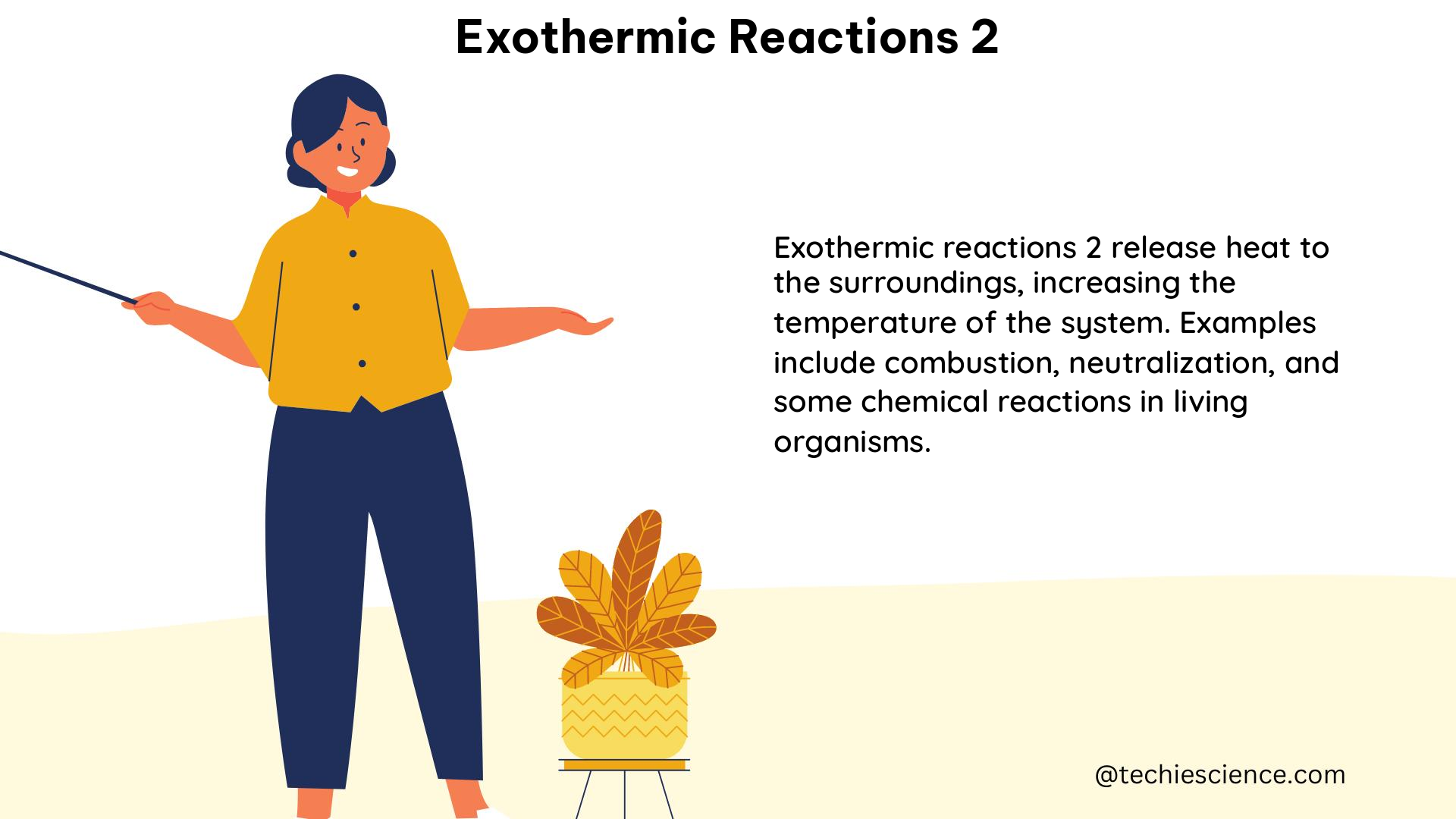Exothermic reactions are chemical processes that release heat energy to the surrounding environment. These reactions are of great importance in various fields, including chemistry, physics, and engineering. In this comprehensive guide, we will delve into the technical details and quantifiable data associated with exothermic reactions, providing a valuable resource for physics students.
Understanding Exothermic Reactions
Exothermic reactions are characterized by the release of heat energy during the chemical process. This heat energy is transferred to the surroundings, causing an increase in the temperature of the system. The amount of heat released can be measured and quantified using various techniques and formulas.
Measuring Temperature Change

One of the most fundamental aspects of exothermic reactions is the temperature change that occurs during the process. The temperature change, denoted as ΔT, can be measured using a thermometer.
Thermodynamic Principles
The relationship between the temperature change and the heat released in an exothermic reaction is governed by the following equation:
Q = m × c × ΔT
Where:
– Q is the heat released (in Joules)
– m is the mass of the system (in grams)
– c is the specific heat capacity of the system (in J/g°C)
– ΔT is the temperature change (in °C)
This equation allows us to calculate the amount of heat released during an exothermic reaction, given the mass of the system and the observed temperature change.
Experimental Examples
- Magnesium Reaction with Hydrochloric Acid:
- When magnesium metal reacts with hydrochloric acid (HCl), the temperature can rise by approximately 60°C.
-
The reaction is highly exothermic, and the heat released can be used to warm the surrounding environment.
-
Aluminum and Iron(III) Oxide Reaction:
- The reaction between powdered aluminum and iron(III) oxide (Fe2O3) is an extremely exothermic process.
- The heat generated during this reaction is so intense that it can melt steel, making it a valuable process in certain industrial applications.
Calculating Heat Produced
The amount of heat produced during an exothermic reaction can be calculated using the formula mentioned earlier:
Q = m × c × ΔT
This formula allows us to determine the quantity of heat released, given the mass of the system, the specific heat capacity, and the observed temperature change.
Example Calculation
Consider the following scenario:
– 50.0 mL of 0.10 M hydrochloric acid (HCl) is mixed with 50.0 mL of 1.00 M sodium hydroxide (NaOH).
– The temperature of the solution increases by 6.9°C.
– The specific heat capacity of the solution is 4.18 J/g°C.
To calculate the heat produced, we can use the formula:
Q = m × c × ΔT
Assuming the density of the solution is 1.0 g/mL, the mass of the solution is:
m = (50.0 mL + 50.0 mL) × 1.0 g/mL = 100.0 g
Substituting the values:
Q = 100.0 g × 4.18 J/g°C × 6.9°C = 2.89 × 10^3 J ≈ 1.0 kJ
Therefore, the heat produced during the mixing of the HCl and NaOH solutions is approximately 1.0 kJ.
Measuring Reaction Rates
The rate of an exothermic reaction can be measured by observing the time it takes for a certain amount of heat to be produced or for a specific temperature change to occur.
Factors Affecting Reaction Rates
The rate of an exothermic reaction can be influenced by various factors, such as:
– Concentration of reactants
– Temperature
– Presence of catalysts
– Surface area of reactants
Example: Hand Warmers
Hand warmers are a common example of an exothermic reaction. The reaction involves the oxidation of iron powder in the presence of air (oxygen).
To measure the reaction rate of hand warmers, one can:
1. Increase the concentration of oxygen by placing the hand warmer in a pure oxygen environment.
2. Observe the time it takes for the hand warmer to reach a specific temperature or the maximum temperature.
3. Compare the reaction rates under different oxygen concentrations to understand the impact on the exothermic process.
Quantifying Energy Released
The energy released during an exothermic reaction can be measured in units of joules (J) or kilojoules (kJ).
Combustion Reactions
One of the most prominent examples of exothermic reactions is the combustion of fuels, such as acetylene (C2H2) in the presence of oxygen (O2).
The combustion of acetylene in oxygen releases a significant amount of energy in the form of heat and light, which can be harnessed for various applications, such as oxyacetylene torches used in welding and cutting.
Calorimetry Measurements
Calorimetry is a technique used to measure the heat released or absorbed during a chemical reaction. By using a calorimeter, the energy released during an exothermic reaction can be precisely quantified.
Conclusion
Exothermic reactions are a fundamental concept in physics and chemistry, and understanding their quantifiable aspects is crucial for physics students. This comprehensive guide has provided detailed information on measuring temperature change, calculating heat produced, determining reaction rates, and quantifying the energy released during exothermic processes. By mastering these technical details, physics students can develop a deeper understanding of the principles governing exothermic reactions and apply this knowledge in various scientific and engineering applications.
References
- UGA Extension. (n.d.). Endothermic & Exothermic Reactions. Retrieved from https://extension.uga.edu/content/dam/extension/programs-and-services/science-behind-our-food/documents/endothermicexothermicreactions.pdf
- RSC Education. (n.d.). Exothermic metal–acid reactions. Retrieved from https://edu.rsc.org/experiments/exothermic-metal-acid-reactions/1731.article
- LibreTexts. (2020). Calorimetry. Retrieved from https://chem.libretexts.org/Courses/Oregon_Institute_of_Technology/OIT:_CHE_201_-_General_Chemistry_I_%28Anthony_and_Clark%29/Unit_8:_Thermochemistry/8.2:_Calorimetry
- LibreTexts. (2019). Quantifying Heat. Retrieved from https://chem.libretexts.org/Courses/Grand_Rapids_Community_College/CHM_120_-_Survey_of_General_Chemistry%28Neils%29/7:_Equilibrium_and_Thermodynamics/7.08_Quantifying_Heat
- Science Buddies. (2020). Qualitative data for exothermic reaction rates. Retrieved from https://www.sciencebuddies.org/science-fair-projects/ask-an-expert/viewtopic.php?t=21356

The lambdageeks.com Core SME Team is a group of experienced subject matter experts from diverse scientific and technical fields including Physics, Chemistry, Technology,Electronics & Electrical Engineering, Automotive, Mechanical Engineering. Our team collaborates to create high-quality, well-researched articles on a wide range of science and technology topics for the lambdageeks.com website.
All Our Senior SME are having more than 7 Years of experience in the respective fields . They are either Working Industry Professionals or assocaited With different Universities. Refer Our Authors Page to get to know About our Core SMEs.